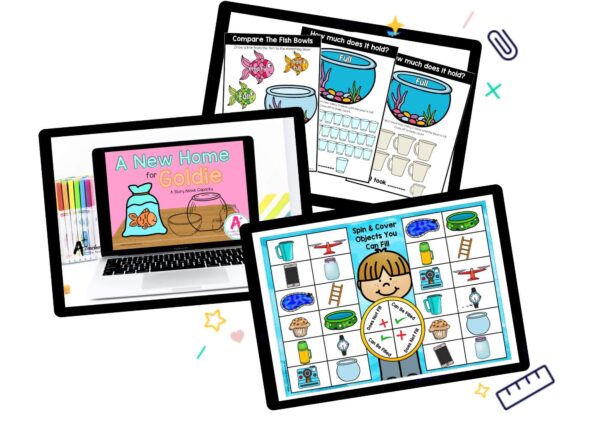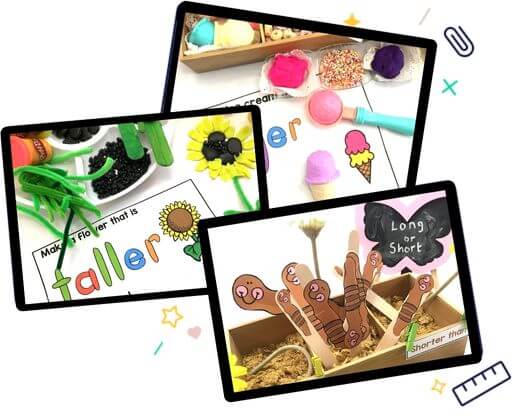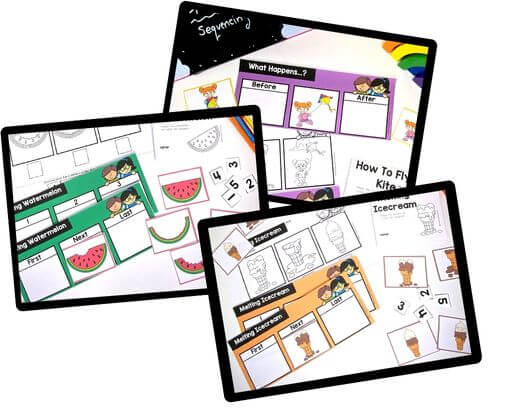Non-Standard Measurement For Kindergarten
Our Non-Standard Measurement For Kindergarten Teaching Resources will help build and explore EYFS measuring skills. Get some hands-on non-standard units of measurement lessons to make measuring length, mass and capacity a breeze!
Teaching measurement is possibly one of the most loved math concepts. Teachers love to teach it and kids love to learn it!
But the Measurement strand is HUGE and includes many concepts that are organised into:
- Using units of measurement – length, mass, capacity, volume, area, perimeter, time, temperature
- Shape – Attributes , nets, area of 2D Shapes & 3D Objects, Prisms and pyramids
- Location & Transformation – Prepositions, directions, flips, slides, turns, grid maps, symmetry, legends, translation, reflection, rotation, enlargements, tesselations, cartesian coordinate system
- Geometric Reasoning – Angles
WOW! Who knew there was so much to cover from K to Year 6?
In this post, we are focussing on Using Units of Measurement for Kindergarten and Pre-primary students.
Non-Standard Measurement For Kindergarten
This area of measurement is concerned with how to “measure” length, capacity, mass, volume, temperature and time.
Again, a massive amount of content to learn, but for EYFS students learning is centred on learning to measure using non-standard units of measurement, not standard units or measuring tools.
Before kids are introduced to Standard Measurement using rulers and measuring tapes they need to understand what is involved in the measuring process, which is why rulers are replaced with non-standard units, like popsticks, paperclips and counting cubes, to measure objects using non-standard measurement. This includes laying multiple copies of a shorter object end to end to express the length of a longer object.
So what is non-standard measurement?
Quite simply, Non-standard measurement is using an informal unit to find out “how much” of something there is.
It’s a process taught to and used by students in Foundation, EYFS, Kindergarten, PrePrimary, Nursery, Reception and Year 1.
The purpose of non-standard measurement is to focus the child on key measuring skills rather than reading tricky scaled instruments. Non-Standard measurement helps kids learn to:
- select the right tool to measure the object being measured
- select the same unit and not different units when measuring an object
- measure without gaps or overlaps
- start and end the measuring in the right spots
- measure it straight
- be precise
Using a variety of non-standard measuring tools, such as Unifix cubes and linking chains, can make learning about length and height engaging and fun for young students.
Introduction to Non-Standard Measurement
Non-standard measurement is a fundamental concept in mathematics that involves using everyday objects to measure length, mass, capacity, and other quantities. This approach is particularly useful in early childhood education, as it helps children develop essential measuring skills and understand the concept of measurement in a more tangible way. Instead of using rulers or measuring tapes, children use items like paper clips, blocks, and counting cubes to measure length and other dimensions. This hands-on method makes learning about measurement fun and accessible, laying a strong foundation before they transition to standard measurement tools.
Which Measuring Concepts Should You Teach?
As we said, the measurement concept is BIG, it includes teaching length, mass, capacity, volume, angles, temperature, area, perimeter, and time using non-standard units then Standard units and finally formula. Before using standard measurement tools, children are expected to grasp the concept of measuring by expressing the length of objects in terms of length units.
But don’t panic, teachers don’t need to teach EVERYTHING in every year level, and these concepts have been shared out across the K- Year 6-year levels as a continuum of learning. Students should understand the concept of length by using multiple copies of a shorter object to express the length of an object in whole number units.
So which measuring concepts should you be teaching in the Preschool, Kindergarten, Foundation or EYFS Years, I hear you ask? In a nutshell, early years teachers need to focus on teaching:
- length
- mass (weight)
- capacity
- time
- area (not in all states)
In early education, it is essential to engage students with hands-on activities using nonstandard units. This approach encourages students to select appropriate nonstandard units for measurement, engage in discussions about their methods, and record and compare their findings.
Fun Non-Standard Measurement Activities
Non-standard measurement activities can be a fun and engaging way to teach children about measurement concepts. Here are some ideas for fun non-standard measurement activities:
- Measuring the Length of a Room Using Footsteps: Have children walk heel-to-toe across the room and count their steps. This helps them understand the concept of measuring length using non-standard units.
- Comparing the Length of Different Objects Using Paper Clips or Blocks: Children can line up paper clips or blocks next to various objects to see which is longer or shorter. This activity reinforces the idea of using same size length units for comparison.
- Measuring the Capacity of a Container Using Counting Cubes or Beads: Fill a container with counting cubes or beads to measure its capacity. This hands-on activity makes abstract concepts more concrete.
- Creating a “Measurement Scavenger Hunt”: Organize a scavenger hunt where children find objects of a certain length or capacity. This interactive game encourages them to apply their measuring skills in a playful context.
- Using Non-Standard Units to Measure the Length of a Picture or Drawing: Children can use items like paper clips to measure the length of their artwork, integrating creativity with learning.
These activities can help children develop their measuring skills and understand the concept of measurement in a more interactive and engaging way.
Integrating Non-Standard Measurement with Other Subjects
Non-standard measurement can be integrated with other subjects, such as science, technology, engineering, and mathematics (STEM), to create a more comprehensive and engaging learning experience. Here are some ideas for integrating non-standard measurement with other subjects:
- Using Non-Standard Measurement to Measure the Length of a Bridge or Structure in a STEM Activity: Children can use blocks or paper clips to measure the length of a bridge they build, combining engineering with measurement.
- Measuring the Capacity of a Container in a Science Experiment: During a science experiment, children can use counting cubes to measure how much liquid a container holds, linking scientific inquiry with practical measuring skills.
- Using Non-Standard Units to Measure the Length of a Picture or Drawing in an Art Activity: In art class, children can measure their drawings with non-standard units, blending creativity with mathematical concepts.
- Creating a “Measurement Museum”: Set up a classroom display where children can showcase their measurement projects. This allows them to share their findings and see how measurement applies to various subjects.
By integrating non-standard measurement with other subjects, children can develop a deeper understanding of measurement concepts and how they apply to real-world situations. This multidisciplinary approach not only enhances their learning experience but also shows them the practical applications of measurement in everyday life.
Explore tags
EYFS Non-Standard Measurement Activities

Capacity - K - PP

Length - Non-Standard

Time - 3 Step Sequencing

Capacity - Non-Standard

Mass - Non-Standard
Can't find what you're looking for?
Send us a request! Use this form to request a resource. Please give details of the learning area, topic, year level, curriculum links. We’ll be happy to take a look to see if we can fit it in. Unfortunately a request does not guarantee we will be able to make it!
"*" indicates required fields
